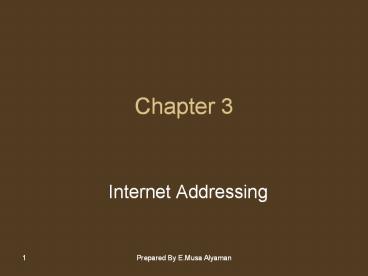Internet Addressing - PowerPoint PPT Presentation
1 / 18
Title:
Internet Addressing
Description:
Chapter 3 Outline Hosts Internet addresses Next Generation Internet ... but they aren t very efficiently allocated Next Generation Internet The solution is IPv6 ... – PowerPoint PPT presentation
Number of Views:106
Avg rating:3.0/5.0
Title: Internet Addressing
1
Chapter 3
- Internet Addressing
2
Chapter 3 Outline
- Hosts
- Internet addresses
- Next Generation Internet
- IPv4
- Class A,B and C addresses
- Domain Name System (DNS)
- Creating InetAddresses
- Java 1.4 Added Methods
- Getter Methods
- Address Types
- Object Methods
- Chapter 3 Highlights
3
Hosts
- Devices connected to the Internet are called
hosts - Most hosts are computers, but hosts also include
routers, printers, fax machines,etc.
4
Internet addresses
- Every host on the Internet is identified by a
unique, four-byte Internet Protocol (IP) address.
- This is written in dotted quad format like
199.1.32.90 where each byte is an unsigned
integer between 0 and 255. - There are about four billion unique IP addresses,
but they arent very efficiently allocated
5
Next Generation Internet
- The solution is IPv6 which uses 128 bit addresses
- Improves services such as multicasting and secure
communication - Not yet widely deployed by ISPs
- Well written Java software should move to IPv6
without modification/recompilation this is one
benefit of abstracted APIs
6
IPv4
- Each 32 bit IP number consists of two components
- The network address
- The unique international address of the network
- The host address
- The unique address of a specific host in the net
- There are three classes of network address
denoted class A, B and C
7
Class A,B and C addresses
192 . 85 . 35 . 87
0...
10...
110...
Network Address Byte
Host Address Byte
8
Domain Name System (DNS)
- Numeric addresses are mapped to names like
www.msn.com or mail.msn.com by DNS. - Each site runs domain name server software that
translates names to IP addresses and vice versa - DNS is a distributed system
9
IP Addresses and Java
- Java has a class java.net.InetAddress which
abstracts network addresses - Serves three main purposes
- Encapsulates an address
- Performs name lookup (converting a host name into
an IP address) - Performs reverse lookup (converting the address
into a host name)
10
Creating InetAddresses
- There are no public InetAddress() constructors.
Arbitrary addresses may not be created. - All addresses that are created must be checked
with DNS
11
Ways to create InetAddress objects
- public static InetAddress getByName(String host)
throws UnknownHostException - public static InetAddress getAllByName(String
host) throws UnknownHostException - public static InetAddress getLocalHost() throws
UnknownHostException
12
Java 1.4 Added Methods
- Java 1.4 adds two more factory methods that do
not check their addresses with the local DNS
server. The first creates an InetAddress object
with an IP address and no hostname. The second
creates an InetAddress object with an IP address
and a hostname. - public static InetAddress getByAddress(byte
address) throws UnknownHostException - public static InetAddress getByAddress(String
hostName, byte address) throws
UnknownHostException
13
Getter Methods
- They return the hostname as a string and the IP
address as both string and a byte array - public String getHostName()
- public byte getAddress()
- public String getHostAddress()
14
Address Types
- Public boolean isAnyLocalAddress()
- Public boolean isLoopbackAddress()
- Public boolean isLinkLocalAddress()
- Public boolean isSiteLocalAddress()
- Public boolean isMulticastAddress()
- Public boolean isMCGloabl()
- Public boolean isMCNodeLocal((
- Public boolean isMCLinkLocal()
- Public boolean isMCSiteLocal()
- Public boolean isMCOrgLocal()
15
Object Methods
- Public boolean equals (Object o)
- Public int hashCode ()
- Public String toString ()
16
Inet4Address and Inet6Address
- Public final class Inet4Address extends
InetAddress - Public final class Inet6Address extends
InetAddress
17
Using InetAddress objects
import java.net.InetAddress import
java.net.UnknownHostExcepion public static void
main(String args) try InetAddress
inet1 InetAddress.getByName("asp.ee.
uwa.edu.au") System.out.println(
"HostAddress" inet1.getHostAddress())
InetAddress inet2
InetAddress.getByName("130.95.72.134")
System.out.println("HostName"
inet2.getHostName()) if (inet1.equals(inet2
)) System.out.println("Addresses are
equal") catch (UnknownHostException uhe)
uhe.printStackTrace()
18
Chapter Highlights
- In this chapter, you have learned
- About the Domain Name System (DNS) and domain
name suffixes (such as .com) - About the structure of an IP address and the
various classes of IP addresses - About the InetAddress class and its various
methods































